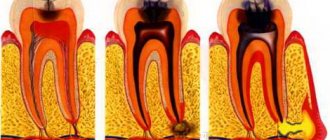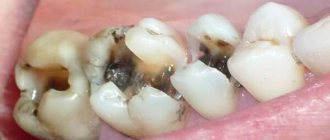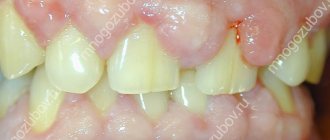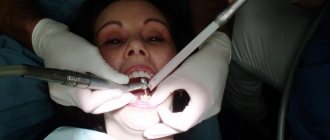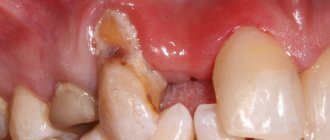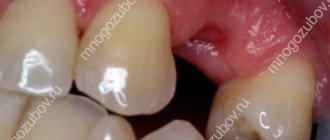Oral diseases, even caries , sometimes lead to very dangerous and serious diseases. Of course, you don’t die from dental caries, but untimely treatment can lead to purulent inflammation or, in other words, an abscess. An abscess is an infectious dental disease characterized by severe inflammation in the area of the tooth root. It is usually found on wisdom teeth and chewing teeth.
Many patients try to relieve symptoms with the help of folk remedies and painkillers, but self-medication in this case only leads to deterioration of health and complications. If no measures are taken in time, a tooth abscess can develop into a tumor, blood poisoning throughout the body, and even a brain abscess (a dangerous disease that can be fatal).
What is an abscess
People who do not pay attention to oral hygiene and proper gum care will sooner or later find out what a tooth abscess is. This is an acute inflammatory dental disease, which is often a complication of other pathologies.
There is an accumulation of pus under the tooth in the gum or hole left after extraction. A dense rounded bulge is formed. This is a fistula - a channel through which pus comes out of the tooth. Sometimes it opens and the contents leak out. But this does not mean that the pathology has passed, because its cause has not been eliminated. If bacteria continue to multiply, pus will again accumulate in the dental canal.
Without timely treatment, it is dangerous to health. An extensive abscess of the jaw may appear, the infection will penetrate into the bone or spread through the blood throughout the body. This threatens the development of osteomyelitis, inflammation of the bone marrow, and sepsis.
Diagnosis and treatment of periostitis
Diagnosing flux is very simple. As a rule, a visual inspection and simple tapping on the tooth is sufficient (the pain intensifies). Additionally, an x-ray may be prescribed, which will confirm the diagnosis definitively or refute it by identifying another disease with similar symptoms.
Therapeutic measures are directed to the source of infection and are designed to minimize the inflammatory process, preserve the tooth and prevent the development of complications. To do this, it is necessary to drain the root canal. During the procedure, not only purification of pus is carried out, but also removal of already dead root tissue. After complete cleaning of the canals, the tooth is filled or an artificial crown is installed, which depends on the integrity of the tooth.
If the infection has progressed sufficiently, the best solution would be to remove the tooth. Otherwise, very serious complications may develop. Drainage can also be carried out through an incision in the area of the gum that is adjacent to the source of inflammation. The most modern and expensive option is to use a low-intensity laser. This method allows you to open the gum and drain the abscess in the least painful way.
In addition, the patient will need to be treated with antibiotics to suppress the infection. To reduce pain and discomfort, it is recommended to regularly rinse with warm solutions or take analgesics.
Types and forms of abscess
Depending on where the pus accumulates, there are three types of pathology:
- gum abscess or gumboil affects only the gums;
- periodontal develops in the periodontal pocket;
- periapical appears with severe destruction of the pulp and other dental tissues.
This pathology often occurs in an acute form and requires immediate dental treatment. But sometimes the fistula opens on its own. The pus comes out and the patient feels relief. If complex therapy is not carried out, the pathology can become chronic.
Complications
If the abscess of the affected tooth is not treated in time, the infection can cause complications: the root of the tooth dies, and the infection can affect the remaining teeth, soft tissues and jaw bone.
Sometimes, with a tooth abscess, the purulent pulp ruptures and pus enters the body, which can cause various chronic diseases.
Symptoms
The main symptom of a tooth abscess is pain. It is localized in one place and intensifies when pressed or chewed. The tooth becomes sensitive to cold, hot or sour foods. If the tumor appears in the upper jaw, pain spreads along the trigeminal nerve.
The following manifestations of pathology are also common:
- malaise, weakness, headache;
- temperature increase;
- swelling and redness of the gums;
- swollen lymph nodes;
- the appearance of greenish discharge;
- the face becomes asymmetrical;
- if there is pus in the mouth, an unpleasant odor and bitter taste appear.
When to see a doctor
Since an abscess is an infectious disease, it has pronounced symptoms. You need to go to a specialist as early as possible. An infection diagnosed in time is easier to treat. Evidence of the spread of infection may include:
- A whitish or reddish swelling on the gum.
- Spread of swelling from the gums to the soft tissues of the face.
- Formation of an ulcer with purulent contents at the site of swelling.
- Severe throbbing pain while brushing teeth or eating.
- The appearance of an unpleasant odor from the mouth, which cannot be eliminated by ordinary daily hygiene products.
- Bitter taste in the mouth.
If there is no treatment and the infection continues to spread, general symptoms will also appear. Body temperature rises, the patient may complain of sleep disturbances, lack of appetite, and depression.
If even some of these symptoms appear, come for a consultation with a dentist at the ARDC clinic. The doctor will conduct a diagnosis and clarify the diagnosis.
Causes of abscess
The main cause of tooth abscess is the penetration of bacteria. This can happen if hygiene rules are not followed, enamel or gums are injured. Pus often accumulates in the tooth in the presence of large carious cavities, pulpitis, gingivitis, and periodontitis.
Sometimes a tooth abscess develops after it is removed. The reason may be failure to follow the extraction technique or the use of poorly sterilized instruments. If removal is difficult, a fragment or piece of root may remain in the hole. But even if the dentist did everything correctly, a gum abscess may develop if the doctor’s recommendations are not followed.
Less commonly, the cause is common infectious diseases. It could be otitis media, sinusitis, pneumonia. The infection is carried into the gums through the bloodstream. At risk are people who eat a lot of sweets, people with diabetes, and people with reduced immunity.
Why self-medication is dangerous
Patients often resort to using traditional medicine while waiting to see a doctor. Such tactics most often only cause harm, because here you should act extremely carefully. If you suspect that you have flux, then do not perform the following manipulations:
- Applying bandages or warm compresses. This method increases the inflammatory process as the infection begins to spread faster.
- Take antibiotics at your own discretion. The use of such drugs must be carried out according to a certain scheme, because bacteria can adapt to the active substance, and the drug becomes ineffective over time. Therefore, medications should only be prescribed by a specialist.
- If you do not feel better 12 hours after the drainage procedure, you should not self-medicate. Contact a specialist immediately.
- Do not take analgesic medications 3-4 hours before your dentist appointment. This can make diagnosis difficult.
Treatment methods
Pathology sometimes does not cause pain at the initial stage, so not everyone goes to the doctor on time. But usually the inflammatory process develops quickly, and within a day a noticeable tumor forms. You definitely need to see a dentist. Only a doctor after an examination can determine how to treat a tooth abscess.
Home remedies such as rinsing the mouth with saline solution or herbal decoctions, as well as taking painkillers, may provide temporary relief, but will not eliminate the cause of the pathology. They can be used if it is not possible to immediately get to the dentist.
Treatment prescribed by a doctor must be comprehensive. Its purpose is to remove pus and destroy infection. The following methods can be used for this:
- drainage of pus;
- cleaning dental canals or sockets after extraction;
- treatment of caries, pulpitis and filling;
- use of local antiseptic and anti-inflammatory drugs;
- taking antibiotics, anti-inflammatory and painkillers.
Opening a tooth abscess is often performed surgically. Some clinics use low-intensity laser. It allows you to painlessly clean the cavity from pus and disinfect it.
If inflammation has developed on a healthy tooth, it can be saved if you consult a doctor in a timely manner. Removal is a last resort; doctors resort to it only in advanced cases. But this is the main method of treatment if an abscess has developed in a baby tooth or wisdom tooth in an adult, as well as in cases where the dental tissue is severely destroyed.
Reasons for the development of inflammation
The main reason for the appearance of a focus of pus is inflammation that was previously present inside the tooth or in the periodontal tissues, and, accordingly, was not cured. We are talking about deep caries, pulpitis, periodontitis, periodontitis or periostitis - gumboil. But besides this, the reasons may be the following:
- poorly treated diseases of the gums and teeth are the number one reason,
- damage to teeth - chips or fractures through which the inflammatory process spreads inside and outside the tooth, i.e. infection,
- infectious ENT diseases: flu, sore throat - in such situations, the infection spreads to the jaw tissue through the bloodstream,
- infection during various manipulations in the oral cavity, as well as lack of sterility: poor sterilization of dental instruments can cause the development of a serious infection, for example, when administering anesthesia.
Disease prevention
The occurrence of such inflammation can be prevented.
To do this, you need to follow preventive measures:
- brush your teeth thoroughly twice a day using not only a brush, but also dental floss;
- change the brush to a new one every 2-3 months;
- eat a balanced diet, limit your consumption of sweets;
- take multivitamins;
- visit the dentist annually for a preventive examination;
- carry out dental treatment in a timely manner and remove tartar.
An abscess is a serious pathology that, without treatment, can lead to dangerous consequences. To avoid this, you should immediately contact your dentist if you experience any problems or discomfort. Simple rules of prevention will help maintain health.
Preventative measures for flux
Prevention of such a disease is almost identical to any other, allowing you to avoid serious dental diseases. It consists of the following:
- Timely visit to the dentist to identify caries or other diseases at an early stage. It is also important to contact a specialist at the first sensation of pain or the slightest discomfort, which will help avoid complications.
- Regular and thorough oral hygiene. This should include not only brushing your teeth, but also using a tongue picker and rinsing your mouth after every meal.
Signs of illness
It is almost impossible not to notice the presence of pathology - the symptoms are always very clear. Anyone, even those far from the medical field, can understand that something is wrong with their gums.
- First there is an acute toothache. It becomes more pronounced if you press on the unit, touch it, or knock on it. It intensifies if the patient drinks or eats something hot or cold.
- Soon the gums swell. Even the cheek may swell. This indicates that the inflammation is spreading quickly.
- A bulge forms on the gum. At first it is red or with a bluish tint. But it also happens that it is not there, and pus simply begins to ooze from the gums.
Due to the purulent masses, the patient has an unpleasant taste and a foul odor appears from the mouth. It is not possible to remove it using standard hygiene products - a toothbrush and toothpaste, since pus continues to actively form after brushing your teeth.
An advanced abscess contributes to an increase in body temperature, decreased appetite, and decreased performance. In many patients, the cervical lymph nodes become enlarged.
Stages of development of gum abscess
| Disease stage | Description |
| Initial | The beginning of inflammation. If the immune system is functioning well, the process may stop on its own. Symptoms are absent or mild. If the immune defense is insufficient, bone or soft tissue begins to melt. Hyperemia of the mucous membrane and discomfort appear. |
| Subacute | The inflammatory process intensifies. Pus accumulates in the pathological area (near the root, inside the periodontal pocket, near the gingival papilla). The pain intensifies. The tooth reacts to irritation. |
| Acute | Progression leads to abscess formation: a cavity with pus forms in the central zone of infiltration. The clinical picture is clearly expressed: the pain is constant, sharp, swelling appears. A lump appears on the surface of the gum, inside of which there is purulent exudate. Inflammation spreads to the submandibular lymph nodes. |
| Chronic | The abscess on the gum spontaneously opens and the contents of the cavity come out. Signs of acute inflammation subside. |
How to treat a tooth abscess
Treatment of a tooth abscess is aimed at eliminating the infectious process and relieving pain. A comprehensive program may include the following activities:
- Opening and draining the lesion. An incision is made on the gum, a drainage is installed through which the pus can freely come out. The drainage system is installed for several days. During this period, the patient is prescribed rinses with antiseptics and saline solutions.
- Endodontic treatment. It involves removing the pulp, treating the root canals with medications and filling them.
- Excision of the root apex. Surgical intervention is performed when the source of infection is located in the periapical area. The surgeon cuts the gum and removes the abscess along with the affected part of the root. The segment itself is preserved.
- Removing a unit. The need for tooth extraction occurs when there is significant destruction of the tooth.
- Therapy with broad-spectrum antibiotics.
- Restoration of the coronal part with a filling or orthopedic construction.
Classification of abscess in dentistry
Doctors say there are three types of tooth abscess:
- Desnev. Only the soft tissues of the mouth are damaged. But, if the disease is started, the periodontal ligaments and periosteum will be drawn into the inflammatory process. Then flux develops.
- Periapical. The pulp is affected. If treatment is not carried out in a timely manner, you will have to perform depulpation or, even worse, tear out the affected unit. More often, this type of disease is diagnosed in children with primary occlusion, which is why dentists have to remove a preschooler’s incisors, canines and molars without waiting for their natural replacement by molars.
- Periodontal. The abscess has a destructive effect on the root, so the tooth becomes loose and falls out prematurely.
The main danger of a purulent tooth abscess is that the pus that has accumulated inside the tumor can penetrate into the blood. Then a general intoxication of the human body will occur. Internal organs, bones, and brain come under attack. A person who ignores the presence of an abscess may develop meningitis, sepsis, and even die.




